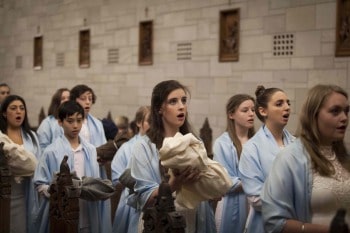Victorian Youth Opera: The Play of Herod
If you witnessed the conviction and stride with which the young enthusiastic performers displayed in their enactment of a world premiere interpretation of The Play of Herod, you’d recognise the great things happening at the Victorian Youth Opera camp at Victorian Opera. Their story of the birth of Christ and King Herod’s subsequent fears of a challenge to his power was hauntingly gripping.

In a work realised by Victorian Opera Artistic Director and composer Richard Mills to a libretto derived from The Fleury Playbook (a medieval collection of Latin liturgical dramas), together with Mills’s own alterations, this revitalised 12th century work encompassed the lofty sandstone interior of the Chapel of the Holy Spirit, Newman College, at the University of Melbourne. I attended Saturday’s 4pm performance, seated amongst a ‘congregation’ facing the chapel’s large west lead-light window emblazoned by the afternoon sun. Alongside the very useful Latin-English libretto booklets provided at each pew, a visor would’ve come in handy. Apart from the glare, however, the 75-minute performance unfolded unblemished.
The dramatic colour achieved by Mills’s music gloved the storytelling tightly. It’s a blend of music that’s difficult to recall but the sense it evoked was powerfully binding. Supported by meandering, eerie strings and prominent percussion and brass, the composition often seems cinematic in breadth and paired with Mills’s distinctive work, the drama feels as equally secular as it does religious.
Director Libby Hall utilised the chapel’s simple, elongated rectangular space effectively, allowing the story to inhabit the altar, the central and side aisles as well as the gallery. Hall juggled her cast of almost 50 performers with a skilful hand across the play’s eight scenes and its finale to achieve a streamlined presentation, with movement of the cast around the chapel’s various parts embracing a sense of occasion.
Since the rich ecclesiastical interior seemed a natural fit for the story, no sets and few props were needed. In mirroring unmistakable biblical fashion, however, Ross Hall’s costumes for angels, shepherds and midwives, in colourful but muted tones, created a richly textured tableau. Within it shone a cast of soloists that anyone familiar with Christianity could identify (the Archangel, the three Magi, Joseph and Mary) – and then the colour black, clothing the tyranny of Herod and his soldiers.
Conductor Phoebe Briggs commanded from high on her podium the 18 members of the Victorian Youth Opera Orchestra, preaching Mills’s music and revelling in the polished musicianship of her orchestra, which was split between altar and gallery. Briggs never let her reach stray. Her three trumpeters later moved from the gallery to become an integral part of the action on the altar. Together with the three trombonists, I was blown away by their flawless brassy majesty.
But, it’s the promise of our young voices that everyone was surely eager to hear and they deserve lashings of praise. Elizabeth Barrow, as the Archangel, appeared and reappeared, confidently ripe and brightly voiced in her reverberant proclamations. Shajeda Kalitzki-Abedin, as Rachel (matriarch of the Hebews), stunned with her purity of tone and emotive magnetism in her lamentation over the death of the children in the Massacre of the Innocents. As Herod, Kiran Rajasingam’s deeply focused performance and expressive voice encapsulated his character’s ruthlessness. And Jacob Lawrence as Archelaus, Herod’s murderous son, will be keenly followed after his ravaging dramatic display, accompanied by a courageously pliant voice and beautiful technique.
Sound vocals and solid performances also came from Luke Bell as the Armiger, Henry Shaw as the Scribe and Daniel Carison, Dylan Casey and Raphael Wong as the three Magi.
Mills’s intention to interpret the work to create greater operatic opportunity than that offered by the original stylistic structure of Gregorian chant certainly paid results. His artists were paralleled marvellously with their characters and vocal lines.
Four performances might seem too few but this work surely has the strength to find its way through many church doors. An early October presentation of a liturgical drama might feel too early for a story intrinsic to Christmas but it did put a smile on my face for the Church having nudged out the heavy commercialism of Christmas by a whisker.


